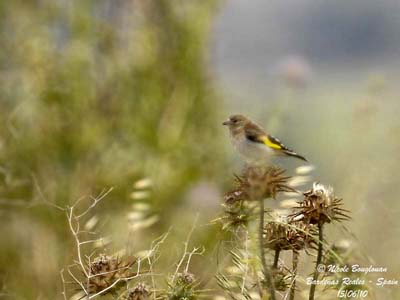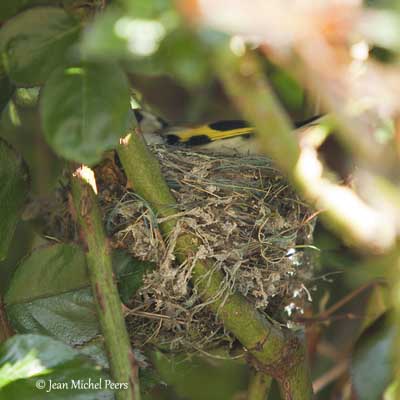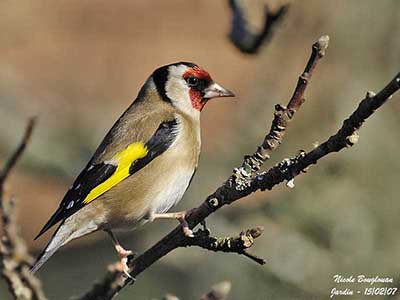
European Goldfinch
Carduelis carduelis
Passeriforme Order – Fringillidae Family
BIOMETRICS:
Length : 12-13 cm
Wingspan : 21-25 cm
Weight : 14-17 g
LONGEVITY: up to 10 years
DESCRIPTION:
European Goldfinch is one of the most colourful birds of our yards.

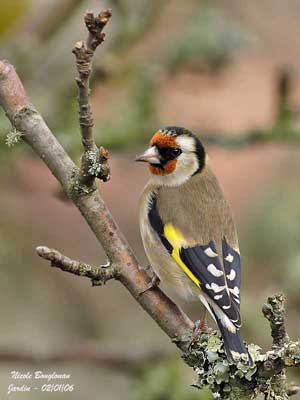
Adult male has brown mantle and white rump. The upperwing is black with bright yellow wing bar and white-tipped flight feathers. Tail is black with white subterminal patches on external rectrices, and white-tipped median rectrices.
The underparts are white, with buff patches on breast sides and flanks.
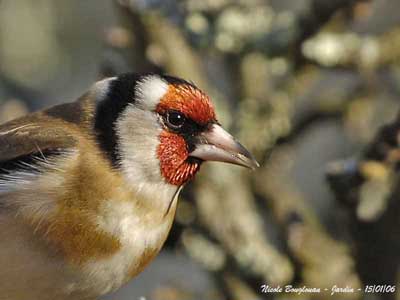
On the head, face is bright red with black lores and base of the bill. Head pattern is black and white, with black head top and sides, and white cheeks, ear-coverts, nape and throat.
The stout, conical, pointed bill is whitish. Eyes are dark brown. Legs and feet are pinkish.
VOICE: SOUNDS BY XENO-CANTO
European Goldfinch’s typical call is a liquid twittering “ticke lit” delicate and melodious.
The song includes twittering phrases and sweeter sounds.
HABITAT:
European Goldfinch breeds in wooded areas, orchards, parks and gardens, thickets, and close to human habitations in cities and villages.
RANGE:
European Goldfinch is partially migratory. It lives in Europe, North Africa, Middle East and Western Asia.
It has been introduced in New Zealand, Argentina, Bermudas and Australia.
BEHAVIOUR:
European Goldfinch covers great distances every day for feeding. It also needs to drink and bathe in the morning and at dusk.
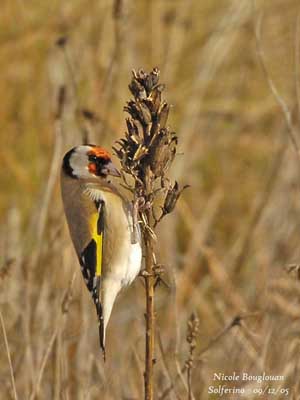
It feeds by hovering from plant to plant, often upside down. The stout, pointed bill of this species allows the bird to crack open the shells and to extract the seed. Its preferred food is the Thistle’s seed, giving its French name to this bird.
They often feed in groups on the roadsides in winter.
European Goldfinch is often aggressive and when they are feeding in groups, mainly at bird-feeders, we can hear several guttural “krrr krrr” between them.
Courtship display involves disputes between males, or males and females. These disputes occur in flight and are accompanied by guttural sounds.
Displays start in March. The male perches close to its mate and stretches the wings alternately while swaying from side to side. These movements display the bright yellow patches of the wings. Female responds by moving her body in the same way.
Male may perform courtship feeding, and female begs food as a young bird, with quivering wings.
During winter, European Goldfinches form large bands feeding and moving together. At night, they roost in thick bushes. Groups of 40 to 100 birds are common.
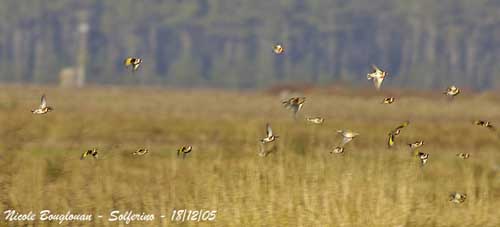
FLIGHT:
European Goldfinch has undulating flight. Undulations are very deep and display the bright colours of this bird.
REPRODUCTION:
Breeding season occurs in spring.
European Goldfinch nests in bushes and trees, often fairly high towards the end of the branch.
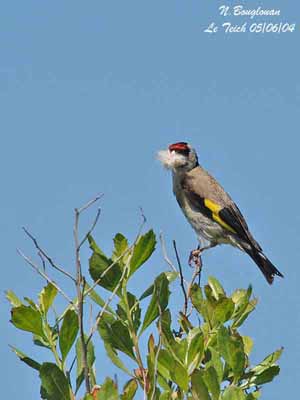
Female builds the nest which is an artwork made with moss, rootlets, dry grasses, lichens, wool and plant down. Interior is lined with more wool, fur and feathers. It is a compact open cup situated between 2 and 10 metres above the ground.
Female lays 5 to 6 bluish eggs, spotted and streaked. Incubation lasts about 12 to 14 days by female alone. Male feeds her during this period.
At hatching, the chicks are partially covered with greyish down, fairly long and thick. Young are fed by both adults with insects and seeds. They fledge about 13 to 18 days after hatching, but they still depend on parents for some days more.
European Goldfinch produces two broods per season, often three.
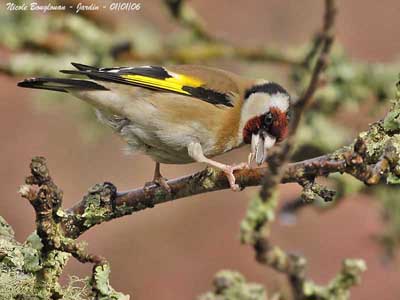
DIET:
European Goldfinch feeds mainly on insects and seeds of Thistles and other plants.
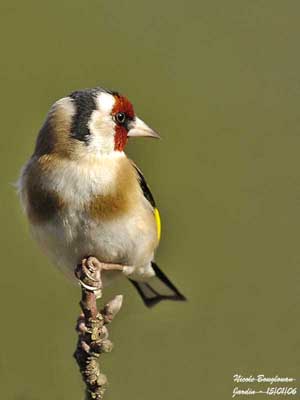
PROTECTION/THREATS/STATUS:
European Goldfinch’s populations declined last century, due to illegal trapping for cage-birds trade.
Declines were also caused by poisoning due to the pesticides used in agriculture intensification.
This species is today protected, and the populations are stabilised.
Fr: Chardonneret élégant
All : Stieglitz
Esp : Jilguero Europeo
Ital : Cardellino eurasiatico
Nd : Putter
Russe : Черноголовый щегол
Sd : Steglits
Photographers:
Jean Michel Peers
JMPN PHOTOGRAPHIE
Nicole Bouglouan
PHOTOGRAPHIC RAMBLE
Text by Nicole Bouglouan
Sources :
THE COMPLETE BOOK OF BRITISH BIRDS – Written by “Royal Society for the Protection of Birds” experts - Préface de Magnus Magnusson - Michael Cady- Rob Hume Editors - ISBN: 0749509112
THE HANDBOOK OF BIRD IDENTIFICATION FOR EUROPE AND THE WESTERN PALEARCTIC by Mark Beaman, Steve Madge - C.Helm - ISBN: 0713639601
L’ENCYCLOPEDIE MONDIALE DES OISEAUX - Dr Christopher M. Perrins - BORDAS - ISBN: 2040185607
The Longevity List (Roland Staav)
Female is similar to male, but the red of the face does not extend behind the eyes as in male. She has shorter bill too.
Juvenile is duller than adults and lacks the face pattern. The head is greyish-white finely streaked with brown. Mantel is olive-brown streaked with dark grey. Breast sides and flanks are dull buff spotted grey.
